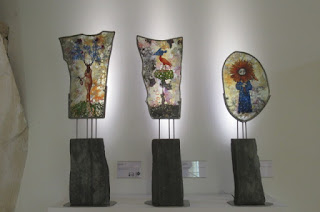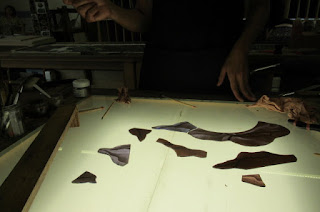Stained Glass
I had been seeing so much "stained glass" in churches and cathedrals, that I was very pleased to learn there was a Musée du Vitrail (Museum of Stained Glass -- "vitraux" are stained glass, plural, as in stained glass windows) in the Poitou region town of Cuzay-sur-Vonne, a whisper of a village in the western part of the Vienne department.
Two aspects of the museum particularly interested me: 1) the display of contemporary colored glass, in addition to descriptions of how it's made (both blown and flat), and its history, particularly in religious settings; and 2) an on-site, resident artisan who showed me step-by-step how a stained glass window is made. My idea of a great time: indulging my senses while learning. Photos and explanation follow.
First, some of the contemporary work exhibited:
Now for the process: I don't know enough about it (and it was explained to me by the artist, Pierre, in French) to be absolutely correct, but you'll get the general idea. Explanations are BENEATH the pertinent photo:
Step 3: The paper is of a particular thickness that it will fit (as will the glass) into the specially-designed, grooved (and malleable) lead edging. Each piece of the "puzzle" (my term) is given a number, and then cut out, very carefully, using special scissors.
Step 4: The paper is then used as the pattern piece to cut the glass (usually 3 mm thick), again using special tools that take into consideration the thickness of the glass.
Step 5: A variety of brushes, kind of sandpaper, and other tools are used to ensure the glass has smooth edges, and then the tough and longest part --
Step 6 -- Painting the glass: Actually, Pierre buys his glass already colored BUT he still has go through the arduous process of grisaille, the "gray painting" which uses a graying powder mixed with vinegar to create shadows, or a three-dimensional effect. And each time a piece is "grayed", it has to be baked, and then baked again, and then... Pierre said that for this piece, it is taking him a month -- just a few days to do the earlier steps, but a couple of weeks to do this one!
Step 7 -- The Armature: Once the pieces are colored, grayed, baked, and assembled according to their numbers, they need to be held together. One way to do this -- as shown below -- is with the malleable lead lengths that have hollowed out centers (the "âme du plomb", or "soul of the lead") into which the glass pieces fit. (There are other methods of holding together the glass pieces; e.g., using copper foil, which is called "Tiffany stained glass".) The lead pieces are then soldered. Pictured below is a very simple sample, to give visitors a basic idea.
Now, suggest you go back up and take a look again at the award-winning piece, "Marie de Médicis". Wow, right?!
A la prochaine --






























Comments
Post a Comment